Population Growth and Survivorship
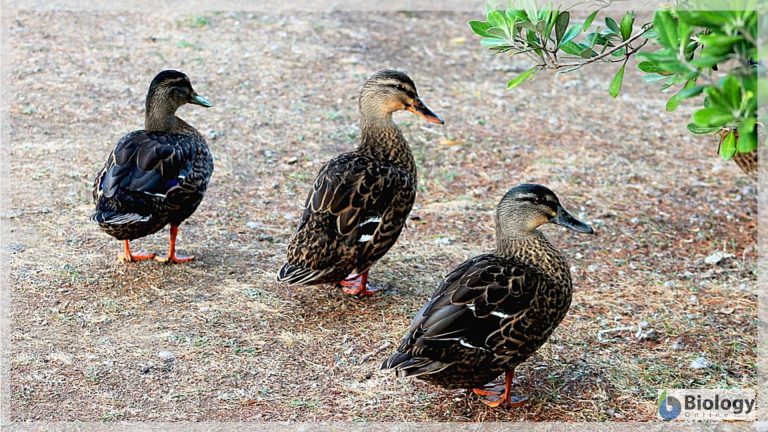
Young ducks in New Zealand
Table of Contents
Previously, we learned about biodiversity and endemism. Now, let’s look at the attributes of populations, the changes affecting populations, and population growth.
What is Population?
In ecology, the population refers to a group of organisms of a particular species that interbreed and live in the same place at the same time. You use the term “community” when you want to refer to all the populations of different species living together in a particular geographical area. Ecosystem, in turn, refers to the community and its environment.
Population Attributes
Population changes over time. The number of individuals in a population over a particular time is the “size” of the population. It is usually denoted by N. When the population size is measured relative to space (that is, per unit area or volume of an environment), then, it is the “density” of the population. For example, the beech trees have a population size of 100 and if all the 100 beech trees are found in one hectare, then, their population density can be expressed as 100 beech trees per hectare.
Measuring population density could depend on spatial distribution. Spatial distribution (or population dispersion) refers to the spatial and temporal pattern of individuals in a particular population relative to one another. A clumped dispersion is characterized by a population forming clusters or patches of social groups. A regular dispersion occurs when the individuals are dispersed more or less evenly or uniformly throughout an area. In the absence of an apparent pattern, the population dispersion is random-type. (Ref. 1)
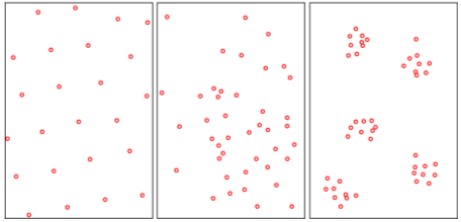
Many populations exhibit a clumped spatial distribution. In this regard, the population density can be measured by the density per unit of total space (called crude density) or by the density per unit of habitat space (called ecological density). By habitat space, it means the space being colonized by clumps or clusters of the population as opposed to the total space that includes both inhabited and uninhabited areas. (Ref. 1)
Spatial distribution is affected by the movement of individuals into or out of the population area. Some of them may emigrate (move out) from a population area to immigrate (move in) to another population area.
Population Growth
When you say a population “grows”, that means the number of individuals in a particular location increases over a period of time.
If the population of a species exceeds the carrying capacity of an ecosystem, then, we say that there is an overpopulation of that species. Overpopulation may result when there are abundant resources and the predators are few.
In cases of heightened predation, the presence of a disease outbreak, loss of habitat, or increased competition for resources, a susceptible population could decline. The population bottleneck is a reduction in the size of the population for a short period of time. However, when these conditions continue for a long time, extinction may ensue.
In our previous lesson on takahē rediscovery, we’ve learned that this species, which was declared as extinct but later on was found again, had dwindled in number because of the compounding effects of abiotic and biotic factors. Habitat loss plus the introduction of species that became their predators are some of the factors that almost drove them to extinction. Through conservation efforts following their rediscovery, their population grows again.
Age Structure
The age structure refers to the proportion of individuals in each age group in a given population. Determining the age structure will give us a hint of the reproductive status of that population. Sex ratio refers to the number of individual females or males per thousand individuals. In a particular population, natality refers to the rate of births whereas mortality is the rate of deaths. A birth-death ratio is called the vital index. (Ref. 2)
An age pyramid is commonly used to depict age distribution. A triangular age pyramid where the base is broad indicates a growing population. It is composed chiefly of young individuals. It also means the birth rate is high. A bell-shaped model indicates a stable population consisting of more or less the same number of young and middle-aged individuals. An urn-shaped age structure signifies a declining population. That means there are more adults than young individuals in the population. This scenario results when the birth rate is drastically reduced. (Ref. 1)
All populations go through these stages: growth, stability, and decline. During the growth stage, the population size increases as there are more births than deaths. The next stage is stability wherein there is no net increase or decrease. This occurs when the number of births is more or less the same as the number of deaths. The stage of decline is when the population size is decreasing. There are more deaths than births at this stage. (Ref.3)
Population Growth Rate
Emigration/Immigration and Births/Deaths are factors that affect population size and density. In particular, births and immigration add individuals to a population whereas deaths and emigration remove individuals from a population. A population growth rate refers to the change in a population over a unit time period. To calculate for it, we can use the formula, {[(births + immigration) – (deaths + emigration)] ÷ initial population} x 100. (Ref. 2) A positive value indicates an increasing population whereas a negative value, a decreasing population. If zero (0), it means there was no net difference in natality and mortality. (Ref.2)
Population Growth Regulation
Suppose we have a pair of kiore (2 Polynesian rats) to start with for this year. This pair can produce 4 pups after almost a month of pregnancy. If these pups are of two pairs, in the eighth month, these pairs can breed and each pair can produce four new pups, thus, a total of 8 new pups. So from a population of 2, the size grows to 14 (2+4+8) in a span of one year. Take note that this projection is based on the hypothesis that breeding happened once for these pairs. In reality, the size could be bigger. Charles Darwin recognized that populations could grow rapidly should there be no limits to growth. (Ref. 3)
The introduction of certain mammalian species to New Zealand brought about major disruptive effects in the ecosystem. One of them was kiore. As the introduced kiore population grew, the competition for resources also grew. Furthermore, they hunted critically-endangered native birds, like takahē and kakapo. Subsequently, these rats became pests.
Despite the tendency to grow rapidly, Charles Darwin pointed out that in reality there are natural limits to population growth so that populations will stabilize. (Ref. 3) Population growth can be regulated through factors, which are of two major kinds: (1) density-independent factors and (2) density-dependent factors.
Density-independent factors are factors that control a population size irrespective of population density. Environmental disasters like forest fires, earthquakes, hurricanes, and tidal waves are density-independent factors. As for density-dependent factors, these are the ecological factors that limit a population size depending on population density.
One of the density-dependent factors is predation. When the population of a particular prey grows, the predators tend to hunt for them more frequently than the other prey. As a result, the number of prey decreases, and the predator population size may subsequently decrease as well.
Competition for resources like food, space, water, and ecological niches is another density-dependent factor. A high population density means higher competition for the available resources. Intense competition in an ecosystem could result in a lower birth rate. (Ref. 2)
Population Genetics
We’ve mentioned that Charles Darwin believed that the population can grow rapidly but because of limitations in the natural resources, it tends to stabilize. To remain constant in size, births should be able to replace deaths. Otherwise, the size declines. And if it continues to diminish it may come to a point that it can no longer persist, thus becomes extinct.
Charles Darwin shared another important observation about population growth — that within a given population there is genetic variation. (Ref. 3) And this genetic variation may have an impact on their population.
Genetic variations are an important source of genetic diversity. When the variation makes the species more adapted to their environment they will be “favored” to thrive and propagate. That is natural selection. It favors the genes that make the species more suited to their environment. Over time, these genes will also become more common than the less favorable genes in the gene pool.
You will know that natural selection is at work when there are variants in a population that out-reproduce other variants.
Changes in the population can also occur when there is genetic drift. We learned in our previous lessons about the various plants and animals found only in New Zealand. And that was largely due to evolution in isolation.
Some of the native species in New Zealand have a lineage that can be traced back to the Gondwanan ancestors. Because of continental drift, genetic drift also occurred. When these ancestors got separated from their Gondwanan relatives, they got prevented from contacting and breeding with one other.
Should they meet again and reproduce, gene migration will occur. This could lead to increased genetic diversity. However, if the genetic differences have already been great and extensive, they may not be able to reproduce when they meet again. In such a case, they have already become different species. (Ref. 4)
Only a few of the native fauna and flora of New Zealand appear to be ancient remnants from Gondwana. (Ref. 5) Most of them evolved and acquired traits that made them more suited to a life on an island. And so, they became more and more genetically different from their relatives. Eventually, they gave rise to new species with unique features.
Now, let’s catch up. In this lesson, we learned about the various attributes of the population. A population grows but can be kept under control through various limiting factors. A population is also dynamic. It undergoes changes as caused by various processes such as genetic variations, natural selection, genetic drift, genetic migration, and speciation. In the final lesson, let’s learn more about populations at the community level.
References:
1. Population Characteristics: 5 Important Characteristics of Population. (2014, January 4). Your Article Library. https://www.yourarticlelibrary.com/pollution/population-characteristics-5-important-characteristics-of-population/23294
2. Gupta, M. (2016, October 19). Population ecology. Slideshare.Net. https://www.slideshare.net/meghagupta149/population-ecologyy-67390978
3. Populations have many characteristics. (n.d.). ClassZone. https://www.classzone.com/science_book/mls_grade7_FL/527_534.pdf
4. The Gene Pool and Population Genetics – Biology Online Tutorial. (2020, August 3). Biology Articles, Tutorials & Dictionary Online. https://www.biologyonline.com/tutorials/the-gene-pool-and-speciation
5. New Zealand Ministry for Culture and Heritage Te Manatu Taonga. (2020). Radiations. Govt.Nz. https://doi.org/https://teara.govt.nz/en/evolution-of-plants-and-animals/page-7
You will also like...
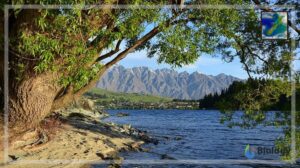
New Zealand’s Unique Geographical History
Explore why New Zealand has such unique flora and fauna, and learn why long periods of geographical isolation. This less..
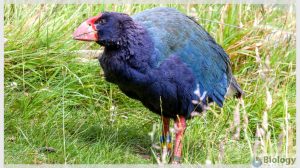
Takahē (Porphyrio hochstetteri)
Meet the colorful takahē, an extremely rare flightless bird. Find out more about its unique features and why they matte..
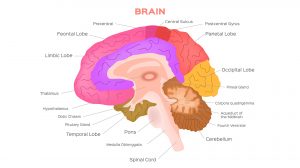
Human Neurology
Human Neurology deals essentially with the nervous system of humans. It also features the various theories put forward b..

Meiosis and Alternation of Generations
Plants are characterized by having alternation of generations in their life cycles. This tutorial is a review of plant m..
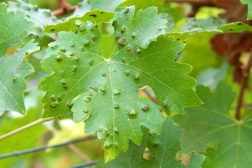
Plant Cell Defense
Plants protect themselves by releasing hydrogen peroxide to fight against fungal invasion. Another way is by secreting c..
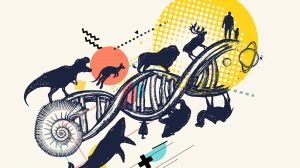
Genetics and Evolution
Humans are diploid creatures. This means that for every chromosome in the body, there is another one to match it. Howeve..
